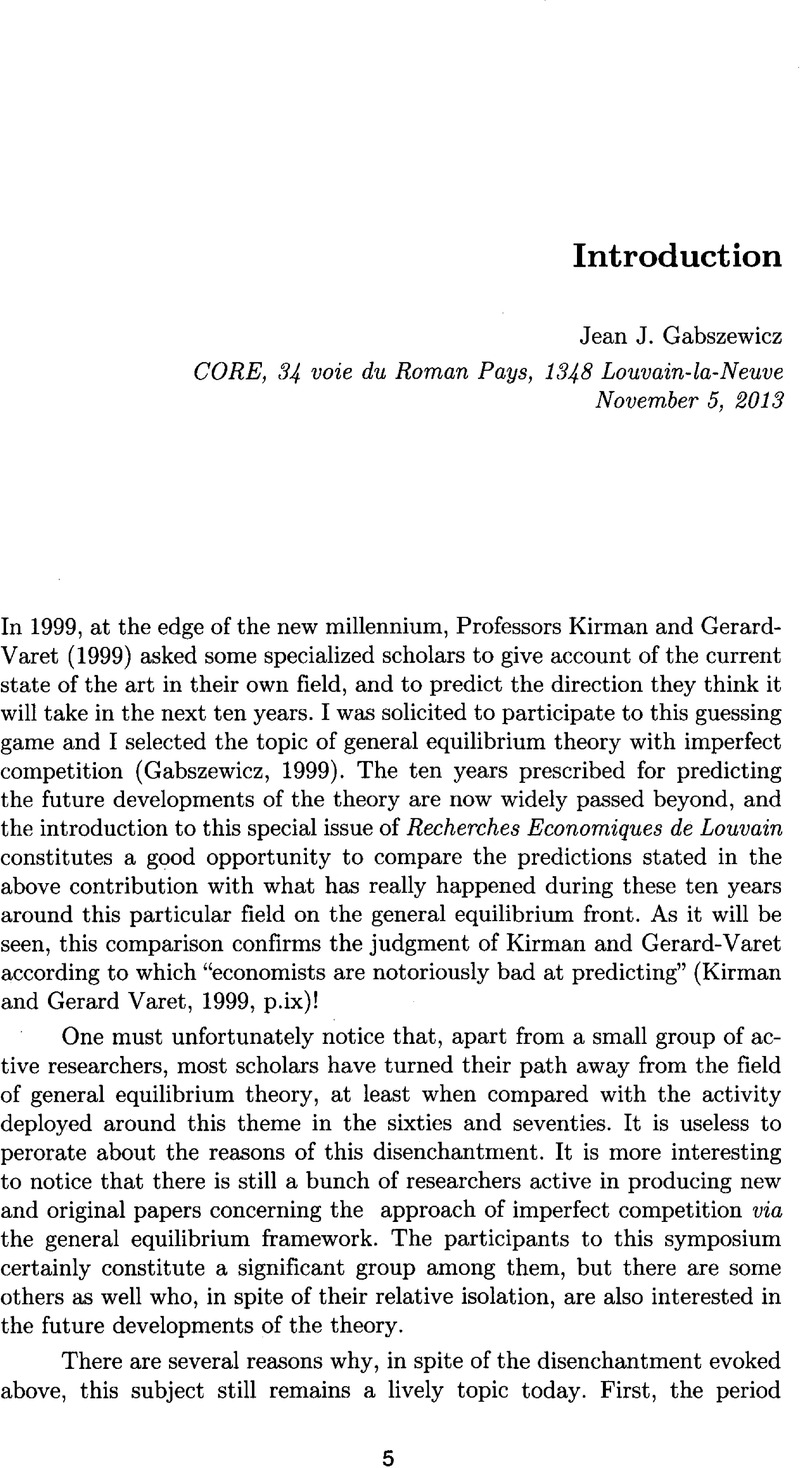No CrossRef data available.
Article contents
Abstract
An abstract is not available for this content so a preview has been provided. Please use the Get access link above for information on how to access this content.

- Type
- Other
- Information
- Recherches Économiques de Louvain/ Louvain Economic Review , Volume 79 , Issue 4 , December 2013 , pp. 5 - 13
- Copyright
- Copyright © Université catholique de Louvain, Institut de recherches économiques et sociales 2013
References
Aumann, R. J. (1973). Disadvantageous monopolies. Journal of Economic Theory, 6, 1–11.Google Scholar
Bergstrom, T., Blume, L. and Varian, H. (1986). On the private provision of public goods. Journal of Public Economics,
29, 25–49.Google Scholar
Bohm, V. (1974). The core of an economy with production. The Review of Economic Studies,
41, 429–436.Google Scholar
Bonnisseau, J-M. and Florig, M. (2000). Oligopoly equilibria in large, but finite, linear exchange economies. Economic Theory,
22, 727–741.Google Scholar
Busetto, F., Codognato, G. and Ghosal S, S. (2008). Cournot-Walras equilibrium as a subgame perfect equilibrium. International Journal of Game Theory,
37, 371–386.Google Scholar
Busetto, F., Codognato, G. and Ghosal, S. (2011). Noncooperative oligopoly in markets with a continuum of traders. Games and Economic Behavior, 72, 38–45.Google Scholar
Busetto, F., Codognato G., G. and Ghosal, S. (2012). Noncooperative oligopoly in markets with a continuum of traders: a limit theorem. Working Paper n. 2012-49, EconomiX, Université de Paris Ouest Nanterre la Defense.Google Scholar
Codognato, G. (1995). Cournot-Walras and Cournot equilibria in mixed markets: a comparison, Economic Theory,
5, 361–370.Google Scholar
Codognato, G. and Gabszewicz, J.J. (1991). Equilibres de Cournot-Walras dans une economie d'echange. Revue Economique (42), 1013–1026.Google Scholar
Codognato, G. and Gabszewicz, J.J. (1993), Cournot-Walras equilibria in markets with a continuum of traders. Economic Theory (3), 453–464.Google Scholar
Codognato, G. and Julien, L. (2013). Non cooperative oligopoly in markets with a Cobb-Douglas continuum of traders. Recherches Economiques de Louvain, this issue.Google Scholar
Cordella, T. and Gabszewicz, J.J. (1998). “Nice” trivial equilibria in strategic market games. Games and Economic Behaviour (22), 162–169.Google Scholar
d'Aspremont, C., Dos Santos Ferreira, R. and Gerard-Varet, L-A. (1997). General equilibrium concepts under imperfect competition: a Cournotian approach. Journal of Economic Theory, 73, 199–230.Google Scholar
Debreu, G. and Scarf, H. (1963). A limit theorem on the core of en economy. International Economic Review (4), 235–246.Google Scholar
Dubey, P. and Shubik, M. (1978). The noncooperative equilibria of a closed trading economy with market supply and bidding strategies. Journal of Economic Theory (17) 1–20.Google Scholar
Dubey, P., and Shapley, L.S. (1994). Noncooperative general exchange with a continuum of traders: two models. Journal of Mathematical Economics (23), 253–293.Google Scholar
Gabszewicz, J.J and Vial, J.-P. (1972). Oligopoly “a la Cournot-Walras” in a general equilibrium analysis. Journal of Economic Theory (4), 381–400.Google Scholar
Gabszewicz, J.J. and Shitovitz, B. (1992). The core in imperfectly competitive economies. In Aumann, R. and Hart, S. (eds), Handbook of Game Theory and Economic Applications (Vol I), North Holland, Amsterdam, 460–483.Google Scholar
Gabszewicz, J.J., and Michel, P. (1997). Oligopoly equilibrium in exchange economies. In Eaton, B.C., Harris, R. G. (eds), Trade, technology and economics. Essays in honour of Richard G. Lipsey,
Edward Elgar, Cheltenham.Google Scholar
Gabszewicz, J.J. (1999). GeneRal EQuilibrium Economics: allowing for imperfect competition. In Kirman, A. and Gerard-Varet, L-A, eds, economics beyond the Millenium.Google Scholar
Julien, L.A. and Tricou, F. (2005). Specialized oligopolies in a pure exchange economy: the symmetric Cournot-Walras equilibrium. Research in Economics (59), 280–292.Google Scholar
Grilo, Isabel and Mertens, J-F. (2009). Cournot equilibrium without apology: existence and the Cournot inverse demand function. Games and Economic Behavior, (65), 142–175.Google Scholar
Hildenbrand, W.
Core and Equilibria of a Large Economy,
Princeton University Press, 1974.Google Scholar
Kirman, A. and Gerard-Varet, L-A (1999). Economics beyond the Millenium.
Oxford University Press, Oxford.Google Scholar
Lahmandi-Ayed, R. (2001). Oligopoly equilibria in exchange economies: a limit theorem. Economic Theory (17), 665–674.Google Scholar
Mas-Colell, A. (1982), “The Cournotian foundations of Walrasian equilibrium theory”. In Hildenbrand, W. (ed), Advances in economic theory,
Cambridge University Press, Cambridge.Google Scholar
Okuno, M., Postlewaite, A. and Roberts, J. (1980). Oligopoly and competition in large markets. American Economic Review (70), 22–31.Google Scholar
Peck, J., Shell, K. and Spear, S. (1992). The market game: existence and structure of equilibrium. Journal of Mathematical Economics (21), 271–299.Google Scholar
Perets, and Shitovitz, B. (2013). Strategic interactions and atoms' power in public goods economies. Recherches Economiques de Louvain, this issue.Google Scholar
Postlewaite, A. and Schmeidler, D. (1978). Approximate efficiency of non- Walrasian Nash equilibria. Econometrica (46), 127–137.Google Scholar
Sahi, S. and Yao, S. (1989). The noncooperative equilibria of a trading economy with complete markets and consistent prices. Journal of Mathematical Economics (18), 325–346.Google Scholar
Shapley, L. (1961). Values of large games, III: a corporation with two large stockholders. R-M 2650,
Rand Corporation, Santa Monica, California.Google Scholar
Shapley, L.S. and Shubik, M. (1977). Trade using one commodity as a means of payment. Journal of Political Economy (85), 937–968.Google Scholar
Shimomura, K-I. and Thisse, J.F. (2012). Competition among the big and the small. Rand Journal of Economics, (43), 329–347.Google Scholar
Shitovitz, B. (1973). Oligopoly in markets with a continuum of traders. Econometrica (41), 467–501.Google Scholar
Shitovitz, B. (1997). A comparison between the core and the monopoly solutions in a mixed exchange economy. Economic Theory (10), 559–563.Google Scholar
Ngo, Van Long and Antoine, Soubeyran (2000). Existence and uniqueness of Cournot equilibrium: a contraction mapping approach. Economics Letters (67), 345–348.Google Scholar




